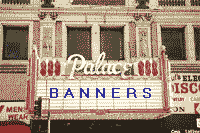Bringing Back the Banner

by Pete Prestipino
01 Sep, 2005
468x60 - Old School Web Trends for New School Marketers
| Every online marketer wants to know how to drive website traffic and enhance an organization's overall branding at an affordable cost. Since the inception of Internet marketing there has been one standby tactic that has worked exceedingly well to boost those corporate impressions and to bring a measurable amount of surfers from targeted online locales - banner advertising, and more specifically advertising using the 468x60 pixel sized graphical banner. |
|
Oh, sure - go ahead and scoff, but online banner advertising still remains a foundation of many Internet marketing campaigns - and for good reason. A well designed banner can motivate users to learn more about a product and introduce a brand's identity to thousands of consumers - directly and indirectly influencing sales and subscriptions.
Thankfully, the much maligned 468x60 advertising format has come a long way since the Web's early days. Initially designed as static billboards on the information superhighway, banners now boast both animation and interactivity to engage viewers and extend the impact of each and every banner impression. Now in direct competition with interactive advertising, or "rich media", it's one of the wonders of the Web that the 468x60 banner has remained in the top drawer of the media buyer and online marketer/advertiser toolbox.
When something works however, it simply works - and there is no denying that this method will continue to make a positive impact well into the future. "A savvy integration of banners in any Web marketing campaign can bring measurable success - more than likely the reason that it has stayed around so very long," said Managing Director of BannersXChange.com Carlos Cruz.
It is that 'savvy integration' that most often eludes website owners who choose to utilize some model of banner advertising initially. As a result, maximizing a banner campaign's ability to convey brand essence while not losing sight of the bottom line is what makes great banners different from mediocre banners.
Making a Difference
The intention of placing ads on websites is to make money by generating sales or to enhance a corporate brand. With new websites and existing companies still coming online at a record pace, agencies and do-it-yourselfers alike are reaching into their proverbial bag of tricks to pull out anything that will make a difference to their Web promotion success.
Banners are not Dead
Banner Relevancy Is Dead.
When Internet users are asked about the characteristics of banners they would click versus those they would not, the answer depends in great part on the relevancy of the ad to the Web surfer. While most existing ad networks do enable advertisers to customize campaigns using a rudimentary process of eliminating categories of business where they do not want to appear, very few advertisers actually do so. Reason being, media buyers want maximum exposure and in some cases are willing to risk irrelevancy even if it means only a handful of additional clicks. Besides, when you are selling something which appeals to a broader audience, it is typically best not to focus solely on the premier sites within a business niche since CPM at these destinations will be exponentially higher than those of less popular but equally viable online properties.
With affordable impression rates per thousands on bulk banner purchasing readily available, most media buyers would rather direct advertisers to uber-targeted locations where cost is high. Subsequently, those media buyers can run through an ad budget quicker, forcing the hand of the advertiser to again replenish the diminished account funds. Not to take anything away from targeted banner buys but if the name of the game is return on advertising spend (and it should be) it would seem logical for advertisers to choose quantity over quality for the sole purpose of enhancing a brand through the increased number of impressions.
468x60 vs. Rich Media
The Continuing Battle for Media Buyer Mindshare
It's true that artistically the old 468x60 just can't compete with rich media advertising. For those not in the know, rich media refers to Internet advertising that utilizes graphically appealing technology that far exceeds the aesthetically kitschy nuances of traditional models and intends to create a sleek interactive atmosphere for users. Unlike static or animated GIF banner advertisements typically used in the 468x60, rich media advertisements often enable users to interact with the banner without leaving the page where it appears. Some popular rich media type banners are created with Shockwave & Flash and it is that interactivity that media buyers are seeking because of their ability to generate clicks.
While development of and maintenance for interactive advertising is generally more costly and thus out of budgetary reach for many advertisers, many other marketers find the dynamic relationship that such advertising creates with users quite intrusive. Take for example recent advertising on a weather site that ran an advertisement for an allergy medication which essentially took control of the user's screen with a very small "close" option available to users. The ad was targeted for those viewers who were looking for information on pollen counts in their area but for other readers simply looking for the ten day forecast it was intrusive and attempts to close the ad resulted in redirection to the advertiser's site.
Should You Bring Back The Banner?
While many online marketers are seeing the glitz and glamour of interactive advertising, banners (yes, primarily the 468x60) remain a useful tool for cost-conscious marketers looking to extend a brand and positively influence an enterprise's bottom-line. Whether or not marketers should recommend the integration of banners into an overall marketing campaign depends greatly on where banners will appear. The quality of those banners and an understanding that while the number of clicks will be lower, the amount of impressions will be greater and will most likely result in greater brand awareness and a more respectable return on advertising spend.
| Instant Survey: Banner Value |

Pete Prestipino
Digital marketing executive with proven experience in all aspects of search engine optimization (SEO), performance-based advertising, consumer-generated/social media, email marketing, lead generation, Web design, usability, and analytics. - 20-year Internet marketing veteran, currently serving as the Digital Marketing Campaign Manager at Antenna Group (formerly Chicago Digital). - Former Editor-In-Chief of Website Magazine, and a regular speaker on Web technology digital marketing strategy - Author of several books on digital marketing Including Web 360: The Fundamentals of Web Success; Affiliate 360: The Fundamentals of Performance Marketing; Domains 360: The Fundamentals of Buying & Selling Domain Names, and SEO 360: The Fundamentals of Search Engine Optimization.
Subscribe to Our Newsletter!
Latest in Marketing









